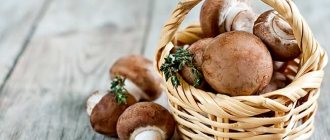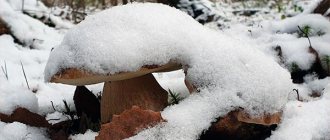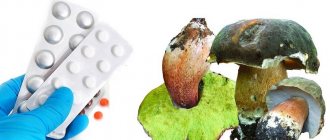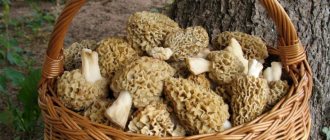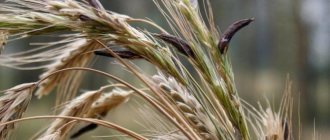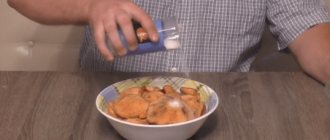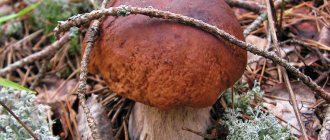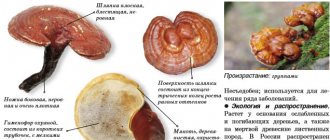We are glad to welcome you to the blog. The mushroom season is in full swing, so our topic today will be edible mushrooms, the photo and name of which you will find below. There are many types of mushrooms in our vast country, so even experienced mushroom pickers cannot always distinguish edible from inedible. But false and poisonous species can spoil your dish, and in some cases even cause death.
In the article you will learn what edible mushrooms are, what types they are divided into, where they grow and what they look like, which mushrooms appear first. I will tell you what benefits they bring to your body and what their nutritional value is.
Classification
All mushrooms are divided into three main sections: edible, conditionally edible, inedible (poisonous, hallucinogenic). These are all cap mushrooms; they make up only a small part of the vast kingdom.
They can be divided according to many criteria. The structure of the cap is of greatest importance to us, since sometimes it is different in twins. Divided:
- tubular (spongy) – the bottom of the cap consists of tiny tubes, reminiscent of a sponge;
- lamellar - plates at the bottom of the cap, located radially;
- marsupials (morels) – wrinkled caps.
You can also divide forest gifts by taste, by the method of spore formation, shape, color, and the nature of the surface of the cap and stem.
Ryadovka
Edible field mushrooms more often than others require preliminary heat treatment. They must be boiled for 15 minutes.
The row is universal in preparation
The lilac-legged rower prefers alkaline soil and chooses pastures and wet fields as its habitat. During growth, it can form “witch circles” or rows. Appearance:
- Hat: up to 20 cm in diameter, pillow-shaped, dense to the touch.
- Hymenophore: lamellar, represented by yellow or cream-colored plates.
- Leg: cylindrical, without narrowing along the entire length. In adults, it is completely smooth, with a slight thickening at the base. The color is pale violet or lilac.
- Pulp: loose, has a fruity smell, tastes a little sweet.
The harvest season is at the beginning of September and does not last long. The row is subjected to all processing methods; in the marinade it turns white.
When and where do mushrooms grow?
In Russia and the CIS countries, mushroom areas are found almost throughout the entire territory, from the tundra to the steppe zones. Mushrooms grow best in soil rich in humus, which warms up well. Forest gifts do not like severe waterlogging and excessive dryness. The best places for them are in clearings where there is shade, on forest edges, forest roads, in plantings and copses.
If the summer turns out to be rainy, you should look for mushroom places at higher elevations, and if it’s dry, near trees in the lowlands, where there is more moisture. Typically, specific species grow near certain trees. For example, camelina grows in pine and spruce trees; white - in birch, pine, oak; boletus - near aspen.
Mushrooms appear in different climatic zones at different times, one after another. Let's look at the middle strip:
- The first spring forest harvest - stitches and morels (April, May).
- In early June, boletus, boletus, aspen, and russula appear. Wave duration is about 2 weeks.
- From mid-July, the second wave begins, which lasts 2-3 weeks. In rainy years there is no break between the June and July waves. In July, the mushroom harvest begins to appear on a massive scale.
- August is marked by massive growth of mushrooms, especially porcini mushrooms.
- From mid-August to early autumn, chanterelles, saffron milk caps, and milk mushrooms grow in huge families when the weather is favorable.
In deciduous forests the main season lasts from June to October, and from November to March the winter mushroom can be found in the forests. In the steppes, field mushrooms are more common: umbrellas, champignons, puffballs, meadow mushrooms. Season: June to November.
Beneficial properties of meadow mushrooms and their use
Caps are a great addition to dishes because they have a wonderful aroma. They also make broth from them; it tastes even better than from the king of mushrooms (white).
Meadow mushrooms are used in the preparation of various sauces. And also for pickling, drying, snacks. In order for the dishes to turn out well, it is very important to know the rules for cleaning and preparing mushrooms.
Rules for cleaning mushrooms
Marasmius oreades dry out quickly, so they need to be cleaned quickly after harvesting. Before the process, select only good specimens; throw away old, moldy, dry, rotting ones.
Wash thoroughly, because there may be dirt, debris, bugs, etc. under their caps. In addition, edible and poisonous specimens grow in close proximity to each other. Dangerous particles can end up on honey mushrooms.
If the mushrooms are dried, there is no need to wash them. It is enough to clean the area under the cap with a knife and cut off dry and moldy areas.
Cleaning before marinating:
- After collecting, soak the mushrooms for 20-30 minutes in water warmed to room temperature.
- Remove hard legs.
- Carefully remove the film from above with a knife, trying not to damage the hat itself.
- You can leave the film on the inside or put the mushroom under running water to wash it off.
- Rinse the caps well.
After cleansing, proceed to the next step.
Cooking features
Before using mushrooms, they must first be cooked. The cooking time depends on what happens to the honey mushrooms next:
Frying and stewing . Boil for an hour in salted water. This happens in 2 stages. First, simply cook the mushrooms for 20 minutes. Then add onion, bay leaf and other spices and keep on the stove for another 40 minutes. Before further preparation, remove from the water and dry slightly.
Freezing . It usually takes about an hour to cook. First, cook for 20 minutes, then drain the water, pour in boiling water and keep on fire until cooked.
Marinovka . Cook for 60-80 minutes until the mushrooms are completely cooked. The old water is drained and boiling water is poured, salt and spices are added.
Preparation of dried mushrooms . In order for the mushroom to regain its shape, it is brought to a boil in salt water. This takes about half an hour.
Cooked honey mushrooms are fried in a heated frying pan for half an hour. If meat ingredients or potatoes are added, the time is increased to 40 minutes. Defrosting frozen mushrooms is not necessary.
It’s easy to understand that such honey mushrooms are ready. They start shooting.
If the mushrooms are not pre-cooked, the frying time is increased to 40 minutes. Before this, they need to be kept in warm water for half an hour.
Other Applications
Negniuchniki have also found their use in alternative medicine. A tincture is prepared from them, which contains a lot of marasmic acid. This substance helps destroy many pathogenic microorganisms, incl. and Staphylococcus aureus.
However, the therapeutic effect has not been clinically proven; self-medication can lead to undesirable consequences. Therefore, before using the traditional method, you should consult your doctor. In addition, non-traditional treatment methods can only alleviate symptoms, but not cure the disease. This requires complex therapy.
Previously, girls collected caps of meadow mushrooms during the full moon. They applied them to their faces, believing that the mushrooms removed freckles, relieved inflammation, evened out skin tone and improved its elasticity.
Composition of mushrooms, benefits
The mushroom composition contains up to 90% water, and the dry part is predominantly protein. That is why the gifts of the forest are often called “forest meat” or “forest bread”.
The nutritional value:
- Mushroom protein contains almost all amino acids, and even essential ones. Mushrooms are an important part of the diet, however, due to the fungin content, it is better to exclude them from the menu for people suffering from kidney, liver and gastrointestinal diseases.
- There are much fewer carbohydrates in “forest meat” than protein. Mushroom carbohydrates differ from plant carbohydrates and are better absorbed, much like milk or bread carbohydrates.
- Fatty substances are absorbed like animal fats by 92-97%.
- The composition contains tartaric, fumaric, citric, malic and other acids.
- The composition contains a large amount of vitamins PP, B1, A. Some varieties contain B2, C, D.
- Mushrooms are rich in iron, phosphorus, calcium, sodium, potassium.
- The composition contains microelements - zinc, fluorine, manganese, iodine, copper.
Edible forest products have many benefits; since ancient times they have been used to treat diseases. Nowadays it is a healthy and tasty food, and vegetarians replace meat with it.
Mushrooms can boost immunity, cleanse blood vessels and lower cholesterol levels, fight depression and excess weight. They help maintain the beauty of hair, skin and nails. Read more about contraindications and beneficial properties of mushrooms on our website.
Raincoat
Unlike other species, these mushrooms prefer slightly arid habitats. They have a specific appearance:
- Fruit body: spherical, pear-shaped or club-shaped. Typically white in juveniles or brown in adults. The surface of some species is covered with small formations that look like thorns.
- Shell: two-layer, the outer layer is smooth, the inner layer is leathery.
- Gleba: whitish (in young), has a strong pleasant smell. When cut, the color gradually changes; in old mushrooms, the gleba becomes a brown or gray powder of spores.
Fruits from mid-summer to late autumn. Young mushrooms are mainly prepared because they are soft and have a distinct, pleasant taste.
Irina Selyutina (Biologist):
The fruiting body of the puffball is located and formed on dense mycelial cords. Initially white in young specimens of the glebe, as the mushroom matures it changes in color and is divided into chambers lined with hymenium. This is where spore formation occurs. When the fruiting body has fully matured, it ruptures at the apex and the basidiospores spill out.
The species is susceptible to polluted environments, so the location for collecting fruiting bodies is chosen carefully.
How to determine if a mushroom is edible or not
How to distinguish edible mushrooms from inedible ones? After all, almost everyone knows boletus mushrooms, but rare and unusual specimens are found in the forest. There are many ways.
For example, as a child I had an interesting encyclopedia with pictures and descriptions, plus I always went into the forest with experienced mushroom pickers. By the way, this is the best idea to take with you into the forest a person who understands mushroom matters.
Some general tips:
- Take a closer look, if you see worms in at least one mushroom from the mycelium, they are edible.
- Tubular species are easier to distinguish from their twins.
- Study the colors, white and greenish often indicate a poisonous counterpart.
- Don't taste the mushrooms; they are not always bitter; for example, toadstool is a little sweet. Such an experiment could result in poisoning.
- A skirt is often found on false and poisonous lookalikes.
This is only a small part of the signs. Basically, each pair of doubles has its own differences. You should pay attention to the frequency of the plates at the bottom of the cap, attachment to the stem, color, pulp when cut, the presence of rings. Below you will find a photo and name of edible mushrooms with a short description.
What do edible mushrooms look like?
White mushroom (boletus)
The mushroom king has a light stalk, the sponge under the cap is cream and white. If you break the cap, it will not darken. He has several false and poisonous twins. For example, the broken leg of a satanic mushroom will turn blue, while that of a gall mushroom will turn pink, and the broken leg will be covered with a dark mesh.
Boletus (redhead)
In most cases, the boletus has a red cap, dense flesh and a leg. When broken, the cut is bluish or white, while the false redhead is red or pink.
Boletus (boletus)
The color of the cap varies from dark brown to light beige. The birch tree has an elongated leg with a gray mesh, and does not change color when cut. The false mushroom has a dirty white or pink sponge, and its cap is gray or pinkish.
Dubovik
A rather massive mushroom with a velvet pillow-shaped cap and lemon-yellow flesh. The stem is red at the base and turns blue when cut. It is confused with the satanic mushroom, but it is lighter in color.
Chanterelles
A real chanterelle is pale pink to orange in color, its edges are wavy, corrugated, and there are plates under the cap. In the false version, the color ranges from orange to red. The edges are jewel-smooth, and when broken, white juice is released.
Butter
Butterwort is a yellow mushroom with a slippery spongy cap, which is connected to the stem by a film. False butterflies have a dark cap, sometimes with a purple tint, with plates underneath it. The skin of the latter does not stretch when removed, and the flesh turns red.
Mosswort
The flywheel is spongy, the sponge is bright yellow. In “youth,” its cap is convex and velvety, but over time, it straightens and cracks. Its color ranges from dark green to burgundy. The leg does not have any special inclusions, and when broken, the color does not change. It is often confused with pepper, gall and chestnut mushrooms. The main difference between the moss fly is that it grows on moss.
Champignon
The original has a beige or cream color, dark brown plates and a skirt. Champignon grows in well-lit places. The popular mushroom can be confused with the toadstool or the stinking fly agaric, which are deadly poisonous. The toadstool has light plates, but no skirt under the cap.
Honey mushrooms
Honey mushrooms come in light cream and brown shades, they have skirts on their legs, and scales on their caps; they are plate-like and grow on stumps. False honey mushrooms are brighter, they do not have a film ring.
Russula
Young russulas have a spherical cap, while mature ones are flat, dry to the touch, matte or shiny. The color changes from green to red. The plates are fragile, different in size, frequent, yellow or white. The pulp is fragile white, changes color when cut. If the russula is bright red or purple, most likely you have a doppelganger.
Raincoat (hare potato, powder coat)
A real raincoat is shaped like a ball, often on a small stem. Its color is white or beige. The pulp is dense, white. The flesh of the false raincoat has a purple tint and the skin is dark.
Saffron milk caps
They often grow near pines and larches. Over time, the hat begins to resemble a funnel, its color is orange, red or bluish-green. It's smooth and sticky. The cut becomes green over time.
Volnushka pink
It has a flat pink cap with a recess in the center and a discreet circle pattern, its edges are curved inward. The pulp is white, dense, the juice is also white. The color does not change when cut. Lookalikes often have scales and a greenish color, different from the white flesh.
Cobweb (swampweed)
It has a beautiful appearance, bright yellow color. The shape of the cap is regular, round, it hides the plates. An adult web spider resembles a toadstool. False lookalikes have an unpleasant odor, are irregular in shape, and are covered in scales.
Umbrella
The umbrella got its name due to its long leg and characteristic shape of the cap, at first it is spherical in shape, then it resembles an umbrella. The color is white with a hint of beige, there is a darker spot in the center and the surface is cracked. The plates darken with age. There are many lookalikes that differ in color, may have a pungent odor and loose flesh.
Talkers
The talker's cap initially has a hemispherical shape, then a depressed shape, reminiscent of a funnel. It is dry and smooth, white, light brown, ocher in color, the center is darker. The plates are white, but darken with age. The pulp is white, dense, although it loosens with age. False talkers are white in color.
Rows
Lamellar mushrooms deserve their name because they grow in rows or circles (witch's circles). The young row's hat resembles a ball and then straightens out. It has white, brown, red, yellow colors. The edges can be curved, smooth, or curved. The skin can be dry, velvety or smooth, slimy. The leg is velvety and often has a pink-brown color. The poisonous doppelgänger is a dirty gray color, so be careful!
lines
It is more often found in pine forests; due to possible frosts, black spots appear on its cap. The cap itself is fused with the stem and has a sinuous shape. It has a brown, brown, reddish or yellow color. The older the line, the lighter the hat. The leg is also not straight, but the flesh is white and breaks easily.
Morel
The surface of the morel cap seems to be covered in cells; it has an ovoid shape. Its color comes in grayish, yellow and brown shades. The morel flesh is white, soft, and the leg has a cylindrical shape, slightly thickened towards the bottom. The false morel grows from an egg, produces an unpleasant odor and is covered in mucus.
Oyster mushrooms
Oyster mushrooms grow on trees, one below the other, which is why they got their name. The cap of oyster mushrooms is smooth, sometimes wavy, and the color is gray with a purple tint. The plates are frequent, dense, and gray in color. The edges are concave, the legs are short and dense. False oyster mushrooms are brighter and have other colors.
Description of meadow mushrooms
The cap's circumference reaches 70 mm. In a newly emerged mushroom it is spherical with a bump in the middle. As it ages, it becomes flat or cup-shaped, but the raised area in the middle remains. Painted in a chocolate tone with a yellowish or scarlet tint. The perimeter is ribbed and uneven; when wet, they begin to show through, and the cap becomes sticky.
The leg is thinned and elongated (up to 100 mm). It comes in the same shade as the hat or a little lighter. They don’t eat it because it’s hard. The ring characteristic of honey mushrooms is absent, because they belong to different families (the usual ones are classified as Strophariidae).
The plates are infrequent and expanded. They change color depending on weather conditions: in rainy weather they are ocher, in hot weather they are snow-white or beige. In young specimens they adhere to the stem, in very mature specimens they peel off.
The pulp is yellowish and does not change its color after harvesting. The aroma is sweetish-spicy, with clove and almond notes.
They have a distinctive feature - they glow in the dark.
Contraindications
Whatever the useful product and whatever gastronomic qualities it has, before consuming you should always take into account not only the benefits, but also the contraindications of boletus variegated. It is recommended to use the mushroom with caution in case of diseases:
- stomach,
- liver and gallbladder,
- kidney
And in the acute stage, it is better to completely exclude dishes with multi-colored boletus from the diet. In any case, it would be a good idea to have a preliminary consultation with a doctor you trust.
Variegated boletus can also cause harm to health:
- women during lactation,
- having an allergy to mushrooms.
If you are prone to allergic reactions, you need to be careful and include boletus multicolored in your diet gradually, starting with a small amount.
Since mushrooms are a rather difficult product for the digestive system, they are not recommended for children under 7 years of age.
Literature:
Lesso T. Mushrooms. Determinant.
Related species
Boletus is a group of species of mushrooms of the genus Leccinum (boletus). In addition to boletus, this genus includes a group of boletus. Representatives of both groups are edible mushrooms.
In addition to the multicolored boletus, several dozen species are classified as boletus. The most common:
- common boletus – Leccinum scabrum;
- gray boletus (hornbeam) – Leccinum carpini;
- Stiff boletus – Leccinum duriusculum;
- marsh boletus – Leccinum holopus;
- black boletus (black cap) – Leccinum melaneum;
- pink boletus – Leccinum oxydabile;
- checkerboard boletus (blackening) – Leccinum nigrescens;
- Ash gray boletus – Leccinum leucophaeum.
Entholom Hostetter
This fragile miracle of nature grows in the tropical forests of India and New Zealand. The bright blue entoloma with a hint of turquoise is easy to spot among fallen leaves and moss, although its size is small - the diameter of the pointed conical cap is no more than 4 cm.
Local mushroom pickers prefer to admire the colorful find from afar, knowing that many species of the Entoloma genus are highly toxic. But the poisonous properties of the blue mushroom have not yet been confirmed; moreover, research is underway on its use as a natural food coloring.
Azulene, a natural pigment known for its anti-inflammatory properties, gives Hostetter’s Entoloma its unusual heavenly hue. The azure representative of the mushroom kingdom is revered by the indigenous population of New Zealand, the Maori tribes. In the local dialect it is called werewere-kokako, due to the similarity of color with the plumage of the endemic bird of the same name.
Entoloma Hostetter is featured on the New Zealand $50 note.
Habitat
The colorful boletus is common in temperate regions of the European part of the CIS, as well as the Urals, Siberia and the Far East. Preference is given to moist soils.
Where does the colorful boletus grow? The fungus forms mycorrhiza (symbiosis with the roots of the plant) with birch, so it can be found near this tree.
Where to collect colorful boletus? It can be found wherever birch trees grow: more often in deciduous and also mixed forests. Although the mushroom grows on peaty and sandy soils, it is especially prolific in wetlands, on hummocks, and on hills among moss. It grows both individually and in small families.
Trametes multicolored
The tinder fungus from the Polyporaceae family is popularly called “Turkey Tail” for its unusual rainbow color and characteristic fan-shaped shape. The size of the fruiting bodies of Trametes versicolor does not exceed 8 cm in diameter, but they are usually found in groups, forming lush rosettes with a common base.
The picturesque tinder fungus is a common species, although it is almost unknown in Russia. It grows on old oaks and birches, less often on logs and stumps, attaching to the trunk sideways.
“Turkey tail” is not edible, but has valuable medicinal properties. In Japan, effective anti-cancer drugs are produced from it, and official medicine recommends including Tratemes versicolor in the therapy of cancer patients. The “rainbow” tinder fungus is valued even more highly in China - there it is grown on special plantations to obtain immunostimulating extracts with strong antibacterial properties.
Mycena chlorophos
During the day, colonies of small, inconspicuous mushrooms from the Mitsen family do not attract the eye. But when night falls, they begin to glow with a bright green light, presenting a fantastic sight. Mycena chlorophos is a bioluminescent species, along with the polypore Polyporus noctilucens or Armillaria mellea. The mechanism of their glow has not yet been studied.
Mycena chlorophos is found in subtropical countries. Among them:
- Indonesia;
- Sri Lanka;
- Japan;
- Polynesian Islands;
- China;
- Brazil;
- Australia.
Selects rotting trunks, individual branches, stumps and fallen pieces of bark. Mycena requires warmth and high humidity - up to 88%, so it appears mainly during the rainy season.
In total, over 75 species of bioluminescent representatives of the fungal kingdom are currently known. All of them emit a greenish glow, thanks to a special pigment substance - luciferin. Only living organisms glow; dead ones lose this amazing ability.
4.8 / 5 ( 46 votes)
Archer's Anthurus or "Devil's Fingers"
A multi-colored mushroom growing in Australia and Tasmania, it has such a strange name for a reason. Its frightening appearance will seem like an innocent joke of nature, compared to the indescribably disgusting smell. A cadaverous stench is emitted by the mature spore mass, attracting flies and other necrophagous insects. So, on the one hand, the anthurus takes care of the reproduction of its own kind, and on the other hand, it protects itself from potential mushroom pickers, because in fact its flesh is not poisonous. But it’s unlikely that anyone would think of not only trying, but even touching this fetid monster.
Archer's Anthurus (Clathrus archeri) belongs to gastromycetes - organisms whose fruiting bodies open during the ripening process. The initially white egg-like mushroom bursts, releasing a bright red receptacle divided into several oblong segments. They resemble either predatory bent fingers, or the folded tentacles of sea anemones. After a while, the receptacle spreads out and lies on the ground, completely covering the leg, which makes the resemblance to the inhabitants of the aquatic depths even stronger.
Another “native” of Tasmanian forests, known as the “Sea Anemone” (Aseroe rubra), has a similar structure, color and, most importantly, smell.
Milky blue
Another edible species, with a slightly appetizing color. Blue milkweed (Lactarius indigo) is a species of russula native to the forests of East Asia, as well as Central and North America. Creates mutually beneficial mycorrhizal associations with evergreen and deciduous trees.
The color of the fruiting body brightens as it grows, changing from denim blue to light blue, while the hymenophore remains intensely colored. The pulp and milky juice also have a “heavenly” hue, but upon contact with air they gradually turn green.
You can buy "exotic indigo" in rural markets in China, Guatemala and Mexico. Here the milkweed is in demand, although it is not considered particularly tasty - its pulp is slightly bitter and has an uneven texture. Usually the product is fried or pickled to neutralize the acrid milky juice. During heat treatment, the blue color is replaced by gray, so that in the finished dish the milkweed does not look like a space alien, but a completely familiar russula.
